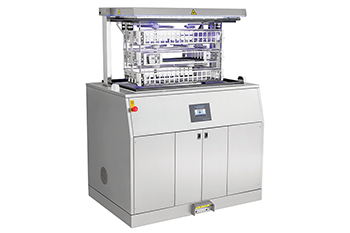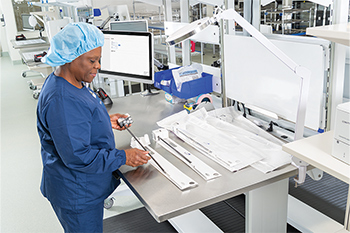Back To The Operating Room, With Confidence
A surgical instrument that arrives in the operating room (OR) and is opened, whether used or not, must be reprocessed. If residual soil is found, additional reprocessing becomes an unrecoverable cost, requiring more instruments to be purchased more frequently and adding to the overall average cost per procedure.
This is an area where a validated automated cleaning cycle can reduce the risk of human error, which may lead to wasteful reprocessing of robotic instruments. Additionally, if a dirty or damaged instrument is found once the set is opened in the OR, the case may need to be delayed or rescheduled, costing facilities valuable resources.

This is critically important when considering the cost of a delayed or canceled case, which sometimes exceeds $2,000 per minute.10 Automation provides consistency and confidence that instruments are cleaned right, every time, which can reduce the risk of delayed procedures to help maximize robotics program ROI.
Efficient Low-Temperature Sterilization
Typically, robotic assisted surgery procedures use an endoscope as well as robotic instruments. The endoscopes used are heat-sensitive and must be processed using a low temperature sterilizer. The V-PRO™ maX 2 Low Temperature Sterilizer processes two da Vinci endoscopes in just 30 minutes, compared to 60 minutes with other systems. This time savings helps optimize your processing and enables staff to reprocess the endoscopes more efficiently.
Let's follow 12 robotic instruments (which would be enough for three cases, depending on the type of procedure) through the reprocessing workflow to see how this works.
As the chart indicates, over two hours are saved via automated washing and disinfection, and three robotic endoscopes can be sterilized in nearly 50% less time using the V-PRO™ sterilizer and CELERITY™ 5 HP Biological Indicator versus competitive products. This combined overall time savings5 enables the sterile processing department (SPD) staff to concentrate on other critical tasks, making the SPD overall more productive.
Maximizing Robotic Instrument Usage
Improved reprocessing speed and the ability to be ready for more procedures each day aren't the only benefits automation, and an optimized workflow, provide. Automated washing and disinfection results in more reliable, repeatable cleaning, so instruments are cleaned right the first time, reducing possible rework. When more instruments arrive more often in the OR without being returned because they are dirty, overall instrument inventory utilization improves.
Let’s assume a hospital performs 425 RAS procedures each year. When considering the instrument costs per procedure, these instruments become a significant line item for the operation. The cost of purchasing another full set to keep up because of slow, unreliable reprocessing adds up quickly. As the chart illustrates, reprocessing instruments so that they are used to the maximum amount of the "reprocessing life counts" can mean hundreds of thousands of dollars in saved versus stranded, wasted costs.


Not using the instruments for 100% of their use life can hurt a hospital's bottom line. Adding more instruments to cover for mistakes during manual cleaning and a workflow that isn't optimized isn't the answer. In the example above, when just 50% of additional instruments are needed to cover unreliable manual workflows, the results are $425,000 in annual costs, which adds $1,000 per procedure in unnecessary costs.5, 8
Robotic Reprocessing Equipment
While the initial costs of an RAS system run upwards of $2 million, as we've seen, the investment in reprocessing equipment is just a fraction and can help maximize the system's capacity and yield cost savings via maximum use of instrument inventory.
While automation via washer/disinfector and the most efficient low temperature sterilization and sterility assurance provide the greatest time and efficiency savings, other best practices greatly aid the effectiveness of reprocessing. These include:
 United States
United States
 Canada (EN)
Canada (EN) Canada (FR)
Canada (FR) Deutschland
Deutschland Italia
Italia United Kingdom
United Kingdom Australia
Australia New Zealand
New Zealand Singapore
Singapore Brasil
Brasil México
México











